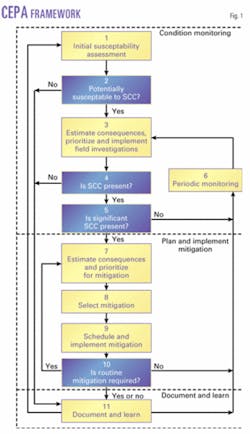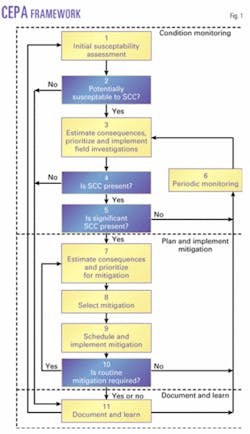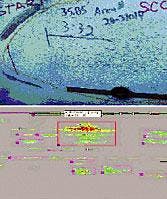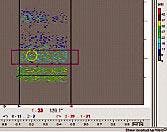Engineers at Enbridge Inc. use high-resolution crack inline inspection (ILI) as their core method for managing stress-corrosion cracking (SCC). Results show that the technology provides a reliable method for detecting cracks and can also be used to better understand the underlying causes of SCC growth.
SCC is a time-dependent cracking mechanism that continues to affect the world's pipeline infrastructure. Enbridge has had success using ultrasonic crack detection, but there are challenges to using the technology. These include preparing the pipeline for the inspection, analyzing the copious amounts of data that the tools collect, determining which features are potentially injurious to the pipeline, selecting features to excavate for detailed inspection, and characterizing the features in the field using nondestructive evaluation (NDE) techniques.
In addition to selecting features for inspection, an operator must also determine the need for repeat inspections. This requires a detailed understanding of the growth rate of the SCC so that proper inspection intervals can be selected.
Researchers are developing new analysis techniques, and Enbridge now uses a "strain rate" approach to determine SCC susceptibility. This work requires a detailed review of operating pressure data and techniques to analyze large amounts of pressure data.
SCC management program
The core elements of a formal SCC management program are condition monitoring, hazard mitigation, and formal incorporation of study data into the process. Enbridge's SCC program includes management systems related to data trending, project planning, personnel accountabilities, and engineering specifications.
All activities and systems are formally documented. Other important aspects include research, industry consensus group involvement, and information sharing with regulators.
The Canadian Energy Pipeline Association's (CEPA) basic framework for an SCC management program forms the basis for the Enbridge program conducted both in Canada and the US.
null
CEPA also publishes and disseminates CEPA SCC Recommended Practices, which describe state-of-the-art industry knowledge regarding SCC management. While Enbridge has been formally managing SCC since the early 1990s, it is the CEPA publication that forms the current state of the Enbridge program.
Monitoring, mitigation methods
There are a variety of technologies and methods used to find and repair SCC. The choice of methods employed by a specific company generally depends on company goals, regulations, and the individual pipeline segment's operating circumstances.
Enbridge has used virtually all available "tools in the toolbox" for SCC management, including hydrotesting, direct assessment, rehabilitation, discrete repairs, probabilistic analysis, and risk assessment. Where the need is appropriately defined, the most precise and effective means of monitoring and mitigating SCC for Enbridge has been through ultrasonic crack detection ILI. By the end of 2004, Enbridge had inspected about 3,600 miles of its large-diameter pipeline network with ILI.
Ultrasonic crack detection ILI results
The first inspections using ultrasonic crack detection ILI tools within the Enbridge system began in 1994. Since then, there have been significant improvements to the tool sensors, electronics, analysis methods, software, and field robustness. Enbridge alone has conducted more than 700 digs based directly on crack detection ILI signals, providing a substantial database for tool calibration.
null
ILI shows the density of cracks in an SCC colony and the complexity of discriminating individual cracks (Fig. 2).
While the technology will find complex crack fields, individual crack interaction and depth profiles within the fields are not provided with high levels of resolution. As a result, the pipeline operator is left the important task of segregating important defects from those that are innocuous in the long term. In other words, critical defects will be detected, but many investigative excavations are also conducted at sites that contain only minor flaws.
Depending upon the length of line inspected and the susceptibility of the pipe to SCC initiation and growth, ILI can identify thousands of SCC colonies. In this way, and in many others, SCC colonies are similar to corrosion colonies detected by ILI, requiring fitness-for-purpose decisions to achieve pipeline safety.
While corrosion defects can be prioritized based solely on the measurements reported by high-resolution corrosion ILI, crack defects are not as well defined through the use of ILI alone. This is largely a function of the ILI technology, but it is also related to the capabilities of field nondestructive testing (NDT) and the fitness-for-purpose formulas (discussed later).
Enbridge applies empirical and probabilistic approaches to establish mitigative steps for addressing the ILI data. The following illustrates one of these methods.
null
Figs. 3a, 3b, and 3c show three SCC colonies detected by ultrasonic crack detection ILI. The images were taken from the B-scan view of the ultrasonic ILI report. The images represent three classifications of SCC colony severity; the colony in Fig. 3a is the least severe and the colony in 3c is the most severe.
Each colony is represented in the ILI data by the number and concentration of ultrasonic reflectors and the amplitude of the signals created by the reflectors. The amplitude is an expression of the size of the flaw that reflects the ultrasound. These scans are created in color so that the reported amplitudes of the individual pixels can be compared. Results from field investigations enabled calibration of the ILI defect sizing.
Field measurements of depths, lengths, widths, and defect interactions were collated and trended in comparison with ILI data. ILI-reported defect lengths and widths were generally precise. Depth results, however, were scattered.
To deal with this, technicians collated depth measurements collected from several hundred colonies observed in the field into probabilistic distributions and took the 95th percentile to represent the maximum depth of each category described in Fig. 3.
They evaluated the ILI-reported lengths and 95th percentile depths using fitness-for-purpose formulas. The low level colonies, represented by Fig. 3a, were well below fitness-for-purpose concerns and therefore did not require field investigation. None of the colonies typical of Fig. 3c exceeded critical fitness-for-purpose criteria but were felt to be of higher concern, and they were excavated to gather further calibration data and to reduce pipeline integrity risk.
Even with the 95th percentile depths, virtually none of the colonies represented by Fig. 3b exceed fitness-for-purpose criteria, but all were thought to be a moderate risk considering possible future growth.
Grouping the ILI results into simple categories, such as those in Fig. 3, allows one to draw fundamental conclusions about SCC occurrence on the pipeline segment. For example, the vast majority of reported colonies were very small and did not require field examination in the near term. The Type 3c colonies were far fewer in number but demonstrated that some low-level colonies may continue to grow, albeit unlikely to critical levels, even after many years of exposure to SCC-susceptible conditions. By overlaying other integrity data, such as pressure history and corrosion ILI data, technicians conducted additional assessments regarding SCC initiation and growth behavior.
A 5-year revalidation period was set as the target for repairing defects. A growth model was developed in consideration of industry-published growth values in combination with growth observations specific to the pipe segment. Defects that could potentially grow to a size exceeding failure criteria within 5 years were investigated in the field.
null
Given the scientific uncertainty regarding the state-of-the-art of SCC growth rate methods, however, the approach was prudent. Prior to 5 years, the pipe segment will be reinspected with crack detection ILI, enabling significant improvement to the understanding of SCC growth rate.
Field NDT description
The field NDT techniques included black-on-white magnetic particle inspection (MPI) to determine the location of the cracking and the Flaw Analysis and Sizing ultrasonic Technique (FAST) for depth estimation. One important goal of the field analysis was to confirm the accuracy of the length-and-depth prediction of the ILI tool.
The MPI technique is well proven and provides accurate length estimates. Depth estimation has typically been challenging; however, Enbridge has had recent success utilizing FAST developed by PfiNDE LLC, Old Saybrook, Conn. This technique utilizes a 70° longitudinal ultrasonic wave to size crack-like flaws.
SCC colonies are inherently difficult to size with NDT techniques because of the geometry of the colony. The presence of the outside cracks makes it difficult to size the inner cracks properly. As a result, the best way to determine the actual depth of the cracks is to remove them with a sanding disk.
Alternately removing small amounts of material and then reinspecting with MPI ensure that an accurate depth is determined. Attempting to characterize the colony for crack interaction presents a challenge as well.
Fig. 2 shows that the cracks can be very small and close together, making them difficult and tedious to measure accurately. This characterization is, however, important both from a fitness-for-purpose perspective and to ensure that industry is characterizing the cracking with a standard method. What is needed, therefore, is an easily used industry standard for characterizing SCC colonies.
SCC characterization
Enbridge has captured data from hundreds of excavations. These data have shown, not surprisingly, that SCC typically occurs in sections of pipeline that contain polyethylene tape coating that has disbonded, largely due to the cohesive clay soils. Knowing this, Enbridge has been looking for additional methods to determine if a section of pipeline is susceptible to having SCC initiate and grow.
More recently, Enbridge has been studying the effect of pressure as a qualifier for SCC susceptibility. The analyses conducted by Enbridge use detailed pressure data captured by the supervisory control and data acquisition system.
The main component of the work involves a linear regression to determine the strain rate that the pipeline is experiencing, based on the rate of pressure increase or decrease. Previous industry research has determined that pressure cycles of a particular R-ratio and strain rate were more likely to cause SCC to grow, rather than lie dormant.
Enbridge pipelines that experience operating conditions deemed susceptible have also exhibited relatively large numbers of SCC colonies as determined by ILI. Based on these results, the strain analysis approach provides a new method of determining pipeline sections that are more likely to exhibit SCC that may continue to grow. As a result, additional operating pressure data are being analyzed to determine which pipelines are expected to have SCC.
One of the challenges with this work includes evaluation of the operating pressure data. There is typically an incredibly large amount of data that can easily contain errant data points if a piece of equipment was not working properly or simply being calibrated. As a result, the data need to be reviewed in detail prior to being used.
Knowing that a pipeline section is susceptible to SCC provides valuable information. The next step is to locate the cracking and determine its significance. ILI characterizations typically provide a length of the colony, a depth range of the cracking, and if possible, a length of the longest single crack.
Based on this information, an operator can perform a fitness-for-purpose analysis to determine if the colony should be excavated. Once it is excavated, the field-sizing techniques become important for determining the accuracy of the ILI. Currently, Enbridge's procedure is to repair all cracking found in the field.
Fitness-for-purpose formulas
The fitness-for-purpose criteria being used apply the dimensions of the crack field to either the NG-18 surface flaw equations, as represented in the Kiefer & Associates Inc. Pipe Assessment (KAPA) spreadsheet, or CorLAS developed by C.C. Technologies Services Inc.
An alternative approach is to analyze the dimensions of the largest single crack. Either way, there is an amount of error associated with the analysis; a possible nonconservative analysis if one only includes the single crack; and a conservative analysis if one assumes the colony is a continuous crack.
Enbridge has a research project to complete burst testing of numerous pipes containing SCC colonies. The objective of the research is to determine if a modification to the failure criterion can be made.
If successful, this could significantly change the number of excavations required following ILI. Additional work will include pull-through testing of the ILI tool to determine if better resolution of the cracking can be achieved. The objective of this work is to determine if the tool can provide a better description of the colony with regards to individual crack lengths, depths, and spacing.
Once again, refining this capability will lead to a reduction in the number of excavations required following an inspection.
Based on a presentation to the 5th International Pipeline Conference (ASME), Oct. 4-8, 2004, Calgary.
The authors
Walter Kresic (Walter.kresic @enbridge.com) is manager of pipeline integrity for Enbridge Pipeline Inc. He is currently cochair of the PRCI Corrosion & Inspection Committee, chairman of the Canadian Standards Association (CSA) Operations and System Integrity Committee, and past chairman of the Canadian Energy Pipeline Association (CEPA) Pipeline Integrity Working Group. Kresic holds a BS in metallurgical engineering from the University of Alberta, Edmonton.
Scott Ironside ([email protected]) is supervisor of materials technology at Enbridge Pipeline Inc. Ironside has held positions in engineering and operations, and most recently he has been focusing on developing Enbridge's crack inspection and excavation strategies utilizing a variety of crack analysis methods. He holds a BS in metallurgical engineering from the University of Alberta, Edmonton.







